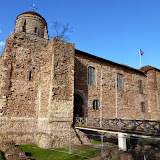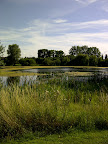“Humpty Dumpty sat on a wall, Humpty Dumpty had a great fall. All the king’s horses and all the king’s men Couldn’t put Humpty together again” (Modern Text)
What a lovely Nursery Rhyme! What has that got to do with where we walking… well we had arrived in the historic town of Colchester, where this “song” had its origins. We were to find out about more of that later as we were wander the streets of the city. Starting out from the Station, we headed our way in to town to find out what it would hold in store for us. The station is a little way out from the main part of the Colchester, so it was not too pleasant at first walking beside some very noisy heavy traffic-laden roads. When reached the bottom of “North Hill” the atmosphere altered as the roadway eased up slightly and the pathway was to take us across a river, which made the area look nice and green. There was a lovely riverside walk to some open parkland and the “Middle Mill”, however we decided to onwards and maybe investigate this later in the day. It was not long before walking amongst some beautiful buildings from a bygone era.
Most of the buildings were Tudor, whether that was in Style or whether they were actually Tudor I am not sure. We passed by a lovely inn named the “The Marquis”, however, it was a little early in our walk to stop for a drink! Just past the pub was St Peters Church, always a good place to find a church next to a pub LOL. A church has been recorded on this site since the Domesday book in 1086 and the building itself has played its part in historical controversy. “Caroline of Brunswick” body rested here for a single night in 1821 when her funeral procession was passing through Colchester. Caroline of Brunswick was married to the then “Prince Regent” of England, their marriage was for political reasons but unfortunately it was a disaster. As a result they lived separate lives, the Prince even banished her from his own Coronation when the time came. When Caroline tried to make her way to the coronation, ill health prevented her and she sadly passed away. Those opposed to the Regent supported Caroline and even when her funeral procession was banned from London they caused havoc and riots by making sure it made it through!
| From 2014 – 22.03.2014 – Colchester |
As we made our finally made our way uphill, we turned to see if we would have been given a view from the top. Unfortunately this was not the case as it was too built up. We meandered down “Crouch Street” for some way, when we spotted an derelict looking Spanish Style Cinema for sale. The cinema was constructed in the early 1930’s by Cecil Masey and was grand in style, with a Wurlitzer Organ and even a stage! Despite remaining open into the early C21st, the cinema did not survive and it closed in 2002. A cinema by the same architect has been saved and is now listed as a Grade 1 building, that is good news as it would be shame if this building was demolished. We turned around, headed back down crouch street and found ourselves in “St Johns Street”, where I spotted the most unusual pub.
Many years ago, people would have been walking not into a pub but a theatre, hence why “The Playhouse” had a very opulent entrance! Opened in 1929 as a theatre it soon was converted to a cinema, but by the early 1980’s it had been converted to a Bingo Hall. It took a popular pub chain to restore the building. Although we did not visit it, I have viewed some photos of the inside and it does look quite stunning :-). We turned away from the street and the pub, making our way into a cool and shady passageway. The overhanging windows, from Tudor style buildings, gave the alley a feel like something from Diagons Alley from Harry Potter! All of a sudden we came out into small square which had a Medieval church, looking very out of place in a modern shopping centre!
| From 2014 – 22.03.2014 – Colchester |
The Church is the only Anglo-Saxon building which still survives in Colchester today. Some of the tower was constructed from Roman bricks, which had been taken from the ruins of the Roman City of Colchester! The church has one important resident, William Gilbert, who discovered electro-magneticism and was Physician to Queen Elizabeth I. I did briefly visit the church, as a vintage craft fair was taking place, it was very tempting to buy lots of items. We headed away from the church and headed up towards the high street. We crossed the high road and found “Museum Place”, eventually taking us into “Castle Park”. The Park was officially opened in 1892 at the Museum Street Gate, but in years gone by this would have been the gateway to “Colchester Castle”! We could see Colchester Castle just beyond the gate and it certainly looked imposing!
As we got nearer we could see it was under going renovation, so it will look really great when it is finished. In 1076 the Normans started work on the Norman keep under instruction from William the Conqueror, it was not completed until C12th. The castle was designed by Gandalf from Lord of the Rings, not really! it was Gundulf, Bishop of Rochester, the man responsible for the White Tower at the Tower of London. The Castle has a peppered history serving as a jail, a base for the ‘Witchfinder General’ witch hunt, surviving being demolished and then for it to become a wedding present! It was the MP Charles Grey in early C18th who restored the Castle to its former glory and created the beautiful gardens surrounding it, upon his death it was sold to the corporation of Colchester who eventually opened it to the public.
| From 2014 – 22.03.2014 – Colchester |
The Nursery Rhyme? I thought that it was associated with the castle,but it was not the castle but St Marys Church which we did not find en-route. The story goes, that during the siege of Colchestergoes, when the gunner known as “One-Eyed Jack Thompson” and his gun known as a “Humpty Dumpty” came tumbling down from the church tower. It could not be place back on and after much struggles in August 1648 the Royalists surrendered and opened the gates of Colchester to the Parliamentarians – Hence “Humpty Dumpty, had a great fall and all the kings men could not put him back together again!”
A little past the castle was the “Hollytrees” Museum, a lovely C18th looking building. It took its’ name from the two holly trees which had been planted in the grounds by Charles Gray in 1729. We started to walk through the Park Gardens, which were quite extensive. We walked behind the castle, where we came across the Park Bandstand. As it was a lovely warm day, it was easy to imagine sitting lazing in the summer sun listening to a band playing some soothing music! As we left the bandstand behind we spotted a Millennium/Jubilee Beacon! I have not seen one in quite some time. This beacon was not just a Millennium beacon, as it seemed older than the others as it was first lit in 1988 to commemorate the 400th anniversary of the sighting of the Spanish Armada in 1588. The sloping grounds we were now walking were once known as “Sheepshead Meadow”, it was here during the C17th when local cloth makers used to stretch out dry out cloth on “tenter frames” to see if it was of good quality. It was here that the term “being kept on tenter hooks” was coined!
| From 2014 – 22.03.2014 – Colchester |
The path eventually led us out of the park, when we came across the “Middle Mill”, which we had seen a sign for earlier in the day. Apparently a Mill has stood in the area since the Norman era, sadly, the actual building was demolished in the 1950’s. The Weir was restored in 2000. From here we took a very long walk from here around Colchester, taking back into St Johns Road. We had both noticed a cycle trail to “Maypole Green” and both felt that it might have been worth investigating. It began to feel like we were walking away from the hurly burly of Colchester Town as the path became much quieter. We were not only walking past parkland, but a large number of derelict buildings. On our way, I spotted a blue plaque for Colour-Sargeant Edmund Fowler VC, who lived here from 1913 – 1925. Edmund Fowler was awarded the Victoria Cross for his Bravery during the Zulu War.
As we followed the cycle trail around, we discovered that a lot of the abandoned buildings had belonged to the MOD (Ministry of Defence). Obviously the MOD have moved out and were elsewhere! The trail gave way to a much more open land, it was very reminiscent of an ex-trainline. As we continued to walk, we saw number of modern, stark looking buildings surrounded by barbed wire. We noted that these were the new MOD buildings which had moved from the delapated area we had seen previously. We followed the trail around to “Maypole Green”, so called as a maypole once stood there in years gone by. With visions of dancers merrily making there way around the Maypole, we thought we would end our walk here for the day as it was getting rather late. From here we made our way back to Colchester Town Station to take the train home.
All the photos can be seen here –
 |
| 2014 – 22.03.2014 – Colchester |
<><














